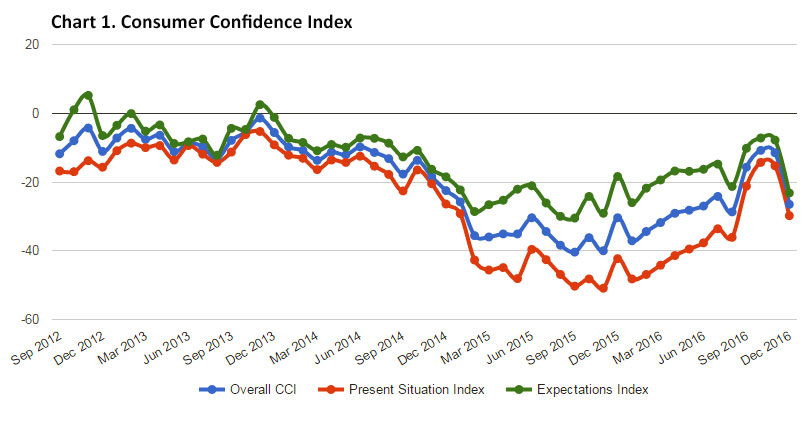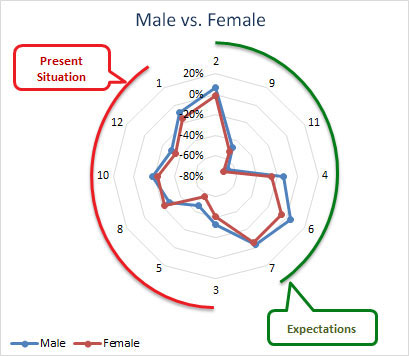Compared to November 2016, the CCI decreased sharply from -11.5 to -26.5 (by 15 points). This is the most dramatic loss of the CCI ever observed since in 2012 we started measuring consumer confidence in Georgia! It has nothing to do with a winter blues, as in the same period of last year (November to December 2015), the CCI went up from -40 to -30.4 (by 9.6 points). Compared to November 2016, the CCI decreased sharply from -11.5 to -26.5 (by 15 points). This is the most dramatic loss of the CCI ever observed since in 2012 we started measuring consumer confidence in Georgia! It has nothing to do with a winter blues, as in the same period of last year (November to December 2015), the CCI went up from -40 to -30.4 (by 9.6 points).
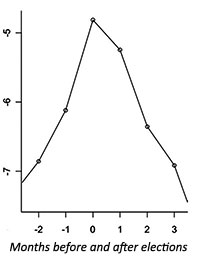 However, in a 2008 working paper, the Greek economists Gikas A. Hardouvelis and Dimitrios D. Thomakos explore the relationship between consumer confidence and elections, using data from 15 European countries from 1985-2007. One of their most striking findings is that consumer confidence peaks around the election date. The graph below, which we took from their paper, shows the average CCI values in their sample around an election. The values on the x-axis denote the distance from the election. Their graph resembles the CCI data in Georgia around the election date.
However, in a 2008 working paper, the Greek economists Gikas A. Hardouvelis and Dimitrios D. Thomakos explore the relationship between consumer confidence and elections, using data from 15 European countries from 1985-2007. One of their most striking findings is that consumer confidence peaks around the election date. The graph below, which we took from their paper, shows the average CCI values in their sample around an election. The values on the x-axis denote the distance from the election. Their graph resembles the CCI data in Georgia around the election date.
Arguably, this is not the only reason why people became pessimistic – like in November; the lari depreciation also has its share. Indeed, for one US dollar, one now has to pay more than 2.70 lari. Within the last 20 years, the dollar was never that expensive in terms of lari!
Already in the past, we observed a strong correlation between the value of the lari and the consumer confidence index. What is special about the current situation (both in November and December) is that two adverse factors (exchange rate and elections) come together and in this way lead to an unprecedented decline of the CCI.
On the other hand, it should be noted that the absolute value of the CCI is still by 3.9 points higher than in December
TBILISI vs. REST-OF-GEORGIA
Among Tbilisians, the CCI went down by 18.2 points compared to November (from -6.4 to -24.6), while for the rest of Georgia it went down by 11.9 points (from -16.2 to -28.1). Possibly, for Tbilisians the negative change was stronger because people living in the regions receive greater shares of their incomes through dollar remittances from relatives living abroad. This part of their income gains in purchasing power if the lari drops, so that they are not hit so hard by the lari slump.
EDUCATION AND AGE
The overall change in CCI for highly educated people from October 2016 to December 2016 is -18 points, while for the rest it is only -9 points. A huge difference! We can also observe a strong difference by age group. For people younger than 35 years, the overall CCI went down by 16.1 points compared to November (from -6.5 to -22.6), and for those above that threshold only by 13.6 points (from -15.2 to -28.8). In the graphs below, one can see that for almost all questions, the reported values have contracted since November for both age groups, but the effect is particularly strong for the young.
Before the elections, we observed exceptionally strong positives changes in the CCI for young and educated people (e.g., in October 2016, the CCI for those below 35 years went up by 8.2. points). It is not surprising if those people whose confidence grew particularly strongly before the election are now most prone to the post-election effect.
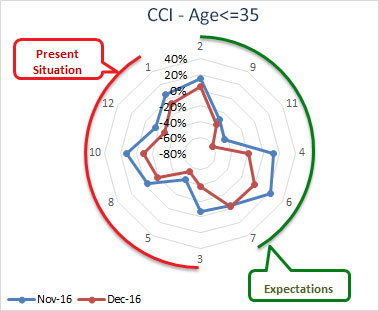 |
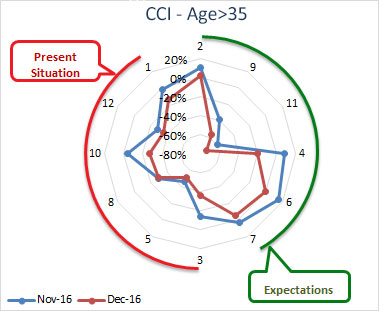 |
As finance professors Ben Jacobson, John B. Lee, and Wessel Marquering write in a 2008 working paper: “Men are strikingly more optimistic about the future performance of key economic and financial indicators than women. We report surprisingly strong and highly significant gender differences in consumer confidence data of seventeen out of eighteen countries, including the US.” In the long term, Georgia is no exception in this respect. Only the October of 2016 was one of the rare occasions when women were more optimistic than men. However, in November and December 2016, women restored their grumbling attitudes: the negative change in CCI for women is stronger (-16.1 points) than for men (-14.3 points), leading to a male CCI lead of 5.9 points and showing that the female CCI lead of 5 points we observed in October was but an exception.
MONTHLY AND YEARLY CHANGES IN THE CCI VARIABLES:

